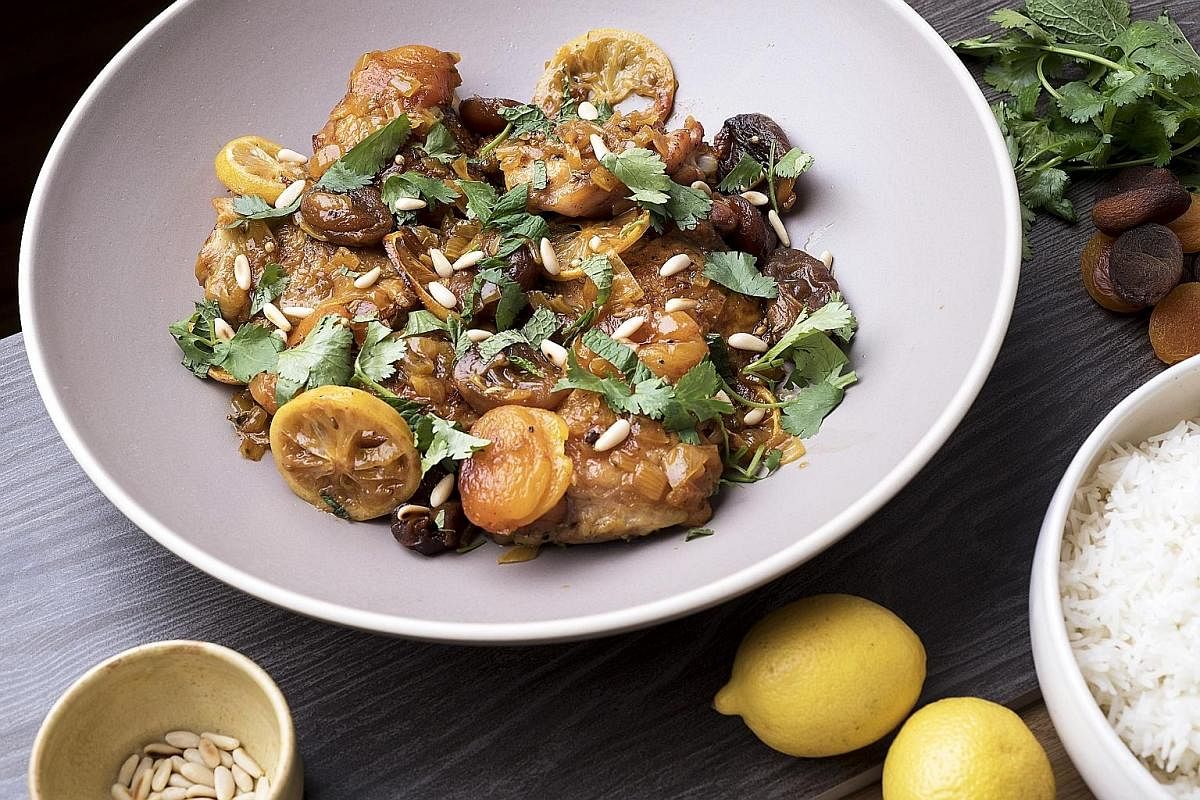-
CHICKEN WITH APRICOTS, LEMON AND SAFFRON
-
INGREDIENTS
6 large bone-in, skin-on chicken thighs, fat trimmed
Salt and pepper
1/8 tsp crumbled saffron threads
2 Tbs lemon juice
1 large onion, diced (about 11/2 cups)
1/2 cup tomato puree
Pinch of cayenne
1 tsp coriander seeds
1 tsp fennel seeds
1 tsp green cardamom pods
1 cup white wine
170g dried apricots (about 1 cup)
2 small lemons, thinly sliced (do not peel)
Cilantro leaves, for garnish
Mint leaves, for garnish
2 Tbs toasted pine nuts, for garnish (optional)
METHOD
1. Season chicken generously on both sides with salt and pepper. If time permits, do this an hour before cooking or up to 24 hours in advance. Keep refrigerated but remove from fridge an hour before cooking.
2. In a large skillet over medium heat, place chicken pieces skin-side down in one layer. Let chicken cook slowly to brown well on one side, for about 15 to 20 minutes.
3. When skin is crisp and lifts easily from the pan, it is ready.
4. Flip and cook two minutes more.
5. Meanwhile, make saffron water. In a small cup, combine saffron with lemon juice and 1/4 cup water. Set aside to steep.
6. Heat oven to 175 deg C. Transfer chicken, skin-side up, to a baking dish. Pour off some fat from the skillet, reserving about 2 Tbs.
7. Add onions, salt lightly and cook, stirring, until softened and beginning to brown, for about 10 minutes.
8. Add saffron water and threads, tomato puree, cayenne, coriander, fennel, cardamom and wine to onions, and bring to a simmer.
9. Pour onion mixture over chicken. Tuck apricots and lemon slices among the chicken pieces. Cover tightly and bake for an hour.
10. Remove cover and bake until lightly browned for about 10 minutes.
This recipe can be prepared to this point up to two days ahead. When ready to serve, reheat in a 175-deg C oven, in a covered pot, for 30 to 45 minutes.
To serve, garnish with cilantro and mint leaves. Sprinkle with pine nuts and serve hot.
Serves four to six.
In praise of the braise
Braising is a flexible method of cooking that keeps meat succulent

Some of the most skilled cooks I know - people who confidently roast, grill and fry - baulk at the notion of braising.
They think that it is more mysterious or fussier than other cooking methods. The opposite is true: Braising is extremely flexible and it follows a formula.
There is an art to it. But since a good braise is so utterly, deliciously succulent, learning how is painless.
You need to understand only the process. It involves gently simmering vegetables, fish, fowl or meat (or a combination) with a small amount of liquid, usually in a covered pot.
Braising chicken is a good place to start and it is a lot easier than you think.
Indisputably, the best part of the bird for this project is the thigh - it is the most succulent cut.
Though a whole chicken chopped in pieces can be braised, skip the heartache of overcooked breast meat and stick to thighs. Your fellow diners will thank you.
A chicken thigh is nearly impossible to overcook. There is forgiveness - 10 minutes longer in the oven simply means a little more tenderness.
Thighs can also be cooked ahead and successfully reheated, often gaining juiciness and depth in the process.
I am not, however, referring to skinless, boneless thighs. You want skin-on, bone-in meat. Fat and bone both impart flavour.
To braise, you will want to season the meat and brown it in a pan, then add onions or other vegetables.
Moisten it all with water, tomatoes, broth or wine and bake in a covered dish for an hour.
Cook it until the meat gives no resistance when probed with a fork.
Uncover the dish and bake for another 10 to 15 minutes to give the dish more colour and concentrate the cooking liquid.
With this template in mind, you can let your imagination go. Dream up braised chicken with thyme sprigs or tomatoes and peppers or wild mushrooms.
Lately, I have had my heart set on tangy braised chicken with apricots, lightly perfumed with saffron and very lemony.
I imagined some commingling of Persian and North African spices. The craving did not go away, nor did I resist it.
Using the method described earlier produced a remarkably flavourful braise. Adding a few coriander seeds, fennel seeds and cardamom pods changed the feel.
Much more than the sum of its parts, this dish has a complexity that belies its easy preparation.
NYTIMES
• The writer is a cooking columnist with New York Times.
Join ST's Telegram channel and get the latest breaking news delivered to you.
A version of this article appeared in the print edition of The Sunday Times on October 15, 2017, with the headline In praise of the braise. Subscribe
